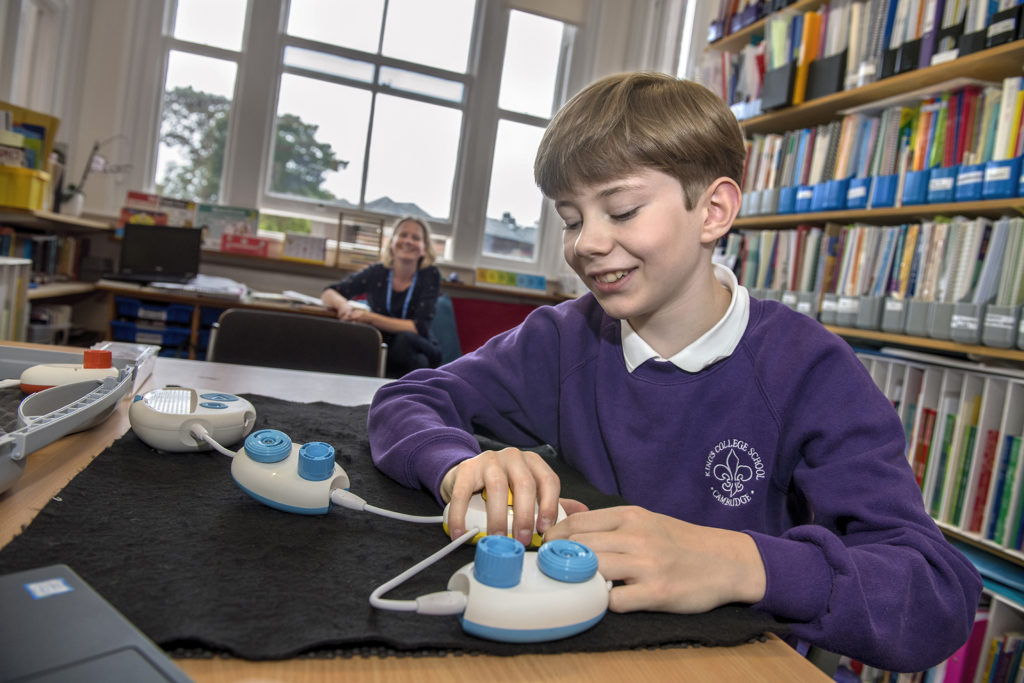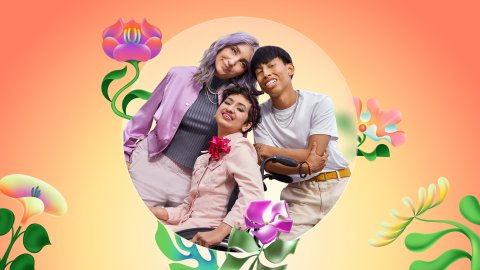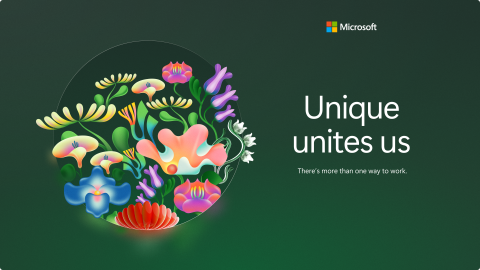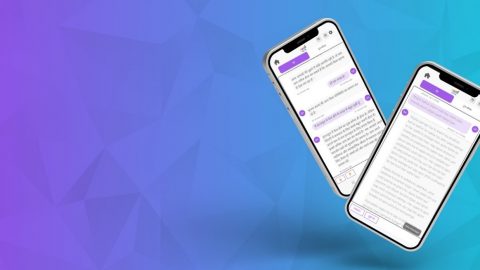Better Together
By Jenny Lay-Flurrie, Chief Accessibility Officer
Kings College Student, Theo, demonstrates a program he created with the technology behind Code Jumper as his mother looks on. Photo by Jonathan Banks.Hi folks, writing to you from Seattle and not from the CSUN Assistive Technology Conference in sunny Anaheim as planned. Unfortunately, I won’t be able to be there in person this year as a health condition is last minute preventing me from flying down. Gutted! I’ve been looking forward to it for months. But no fear, there are 94 Microsofties from across the company in attendance and eager to share what we’ve been up to, and more importantly, to listen, learn, and foster relationships.
Since I can’t be there, thought I would take the opportunity to share what I was going to cover during my presentation – which will go ahead tomorrow with some of our super stars at the helm!
Each year, this event brings together folks from across the accessibility community to share knowledge and best practices in the field of assistive technology. Accessibility isn’t a space where we can move the dial alone, so effective partnerships are a critical element to creating products that work better for everyone. There are some great examples of this that I want to share. As a company, we’re building a partnership mindset into our DNA and into each of our four key pillars which ground us on our journey with accessibility. Enough talk—here’s some examples:
Pillar One: People
Building accessibility into your company starts by building a culture that embraces accessibility and disability. Hiring diverse and talented people with disabilities and accessibility experts brings experiences that empower and accelerate efforts to build products that work for everyone. One of the programs we launched a few years ago is our Autism Hiring Program. While this program matures, we are equally focused on how we share our learnings and best practices in finding talent with other companies with similar ambitions. Today, 16 companies are working together to learn and share together via the Autism @ Work Employer Roundtable. We wanted to make it easier for folks to know how to get started, and in partnership with Disability:IN, SAP, EY, and JP Morgan Chase and the University of Washington, we’ve developed a new playbook that walks through all the top questions you may have. Do check it out.
Pillar Two: Systems
To really drive the business of accessibility, you need a systematic framework; an ecosystem for how you empower folks to deliver. That ecosystem covers all aspects of the company, and supporting our customers is a key part. We have many other partnerships, such as Be My Eyes, which last year started providing customers a direct connection to receive technical assistance from the Disability Answer Desk (DAD), a free consumer service for Microsoft’s customers with disabilities. Since launching the Be My Eyes service in 2018, and we’ve already taken over 4,000 calls and customer satisfaction is at 90%. This partnership was a great step forward in providing people with disabilities effective support in the way they prefer, and is just the start of what’s possible down the line. We’re also excited to announce that tomorrow DAD will be launching Twitter support in five markets. Customers will now be able to send us a direct message via Twitter for technical assistance through the DAD support page.
Pillar Three: Product
When you combine an inclusive culture with an ecosystem that empowers people, and you do it in partnership, you’re set up to create game-changing products that work for everyone.
Windows 10: We are looking forward to meeting users to get feedback about the latest accessibility improvements and to share what’s coming later this year. And yes, there are announcements for Narrator, including support for Chrome. Narrator is also getting new Home Page that makes it easier to find the User Guide, Quick Start tutorial, new settings to personalize your experience, and links to provide feedback so that we can continue to focus on the features that matter most to users. Narrator is also getting improved reading functionality; it is more efficient (less verbose), more natural and more responsive with apps like Outlook. It will also see additional support for the latest translation tables and braille displays.
We’re also building on the success of larger text options by adding larger pointers. Users can make their pointer easier to see by making it larger and adding a custom color – I recommend red. We’ve also polished “center mouse mode” in Magnifier to make your pointer find the center of your display. The team is very proud of its “buttery smooth” performance!
Office 365: Our enthusiastic partners are embedded in every part of our design process—from concept testing, to post-launch feedback from users leveraging the Disability Answer Desk – a number of experts have helped to build an accessible-by-design product that we hope makes it easier for digital inclusion to be part of your organization’s digital transformation.
The ATHEN group played a particularly crucial role in the development of the new and simplified ribbon found at the top of every Word document and OneNote notebook. The simplicity of the new simplified ribbon was designed to allow screen reader users to more easily find the commands they are looking for. Turns out, it is an easier experience for everyone!
Another important advancement is with our Accessibility Checker. We have updated the rules for accessibility checker to reduce false positives making accessibility even easier to achieve to empower everyone. In addition, you can now ‘check as you go’ by letting the accessibility checker keep an eye on your document while you’re building it. This provides an at-a-glance reminder in the status bar when issues exist in the document, and a 1-click action to investigate recommendations.
AT Partnerships: Our assistive technology partnerships are critical to ensuring we can truly empower people with disabilities. We are passionate about our first-party tools, but also passionate about empowering the ecosystem at large. We’re successful not only when we build ourselves, but when we empower others to build as well. A few examples include Eye Tech Digital Systems, which integrates with the built-in eye-tracker on surface; Dolphin Computer Access’ GuideConnect, a talking digital assistant; and InsideVision’s InsideOne, a tactile tablet with an integrated braille keyboard. These are just a few examples, and we’d like to say a huge thank you to our partners for their ongoing collaboration to push the boundaries of assitive tech.
Accessibility Insights: We also have great news for developers with the open sourcing of Accessibility Insights – a tool that helps developers find and fix accessibility issues in their code. Accessibility Insights offers developers the ability to run FastPass and identify common accessibility issues early in the dev cycle and provides tips on how to fix. In addition, we partnered with Deque Systems to add Windows platform support to the axe accessibility rules engine. Now developers can test their code in development using a common, unified approach. I really encourage you to learn more about Accessibility Insights by checking out Keith Ballinger’s latest blog.
Pillar 4: Innovation/Future
Lastly, what we crave: innovation. It motivates, inspires and drives us. Building solutions with and for people with disabilities by harnessing so much of the knowledge we have across the industry and working in partnership with the community to ensure what we built has impact and purpose. Two projects that epitomize this:
Seeing AI: Designed for the blind and low vision community, this research project and free mobile app harnesses the power of AI to describe people, text and objects. The team announced new features and functionality inspired by feedback and recommendations provided by the Seeing AI user community. These updates are all live today – check them out!
- Explore photos by touch feature: tap your finger to an image on a touchscreen to hear a description of objects within an image and the spatial relationship between them.
- Native iPad support: For the first time we’re releasing iPad support, to provide a better Seeing AI experience that accounts for the larger display requirements.
- Channel improvements: Customize the order of your channels, access face recognition function while on the Person channel, get audio cues while analyzing photos in other apps!
Code Jumper: Lastly, Code Jumper is a physical programming language for kids between 7 and 11 with all ranges of vision. It started as a Microsoft research project in the UK, but as it evolved the team worked to create a path to manufacture at scale. The research and technology behind Code Jumper is now in the capable hands of the American Printing House for the Blind (APH), a nonprofit based in Louisville, Kentucky, that creates and distributes products and services for people who are blind or with low vision. Over the next five years, APH plans to offer Code Jumper and related curriculum to students throughout the world. Learn more about the project here.
Check out this post for all the Microsoft sessions this week. Our accessibility engineers, program managers, and world-class researchers are excited to talk to you. Again, I wish I could be there with you!
For more information and to stay up to speed about Microsoft accessibility, visit www.microsoft.com/accessibility








